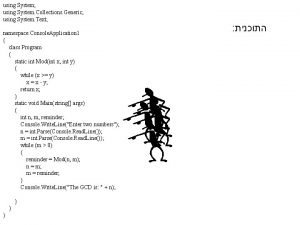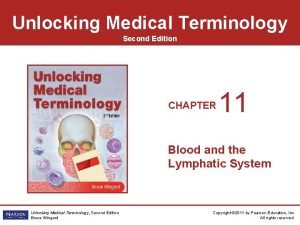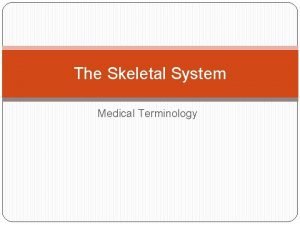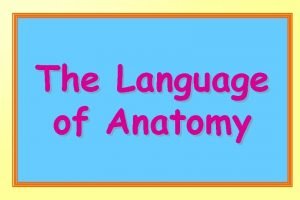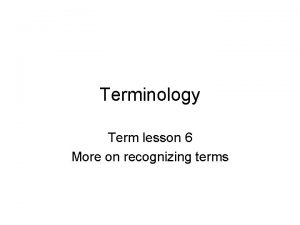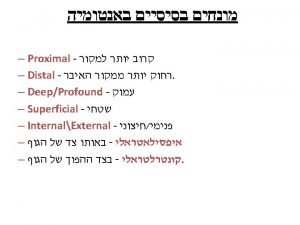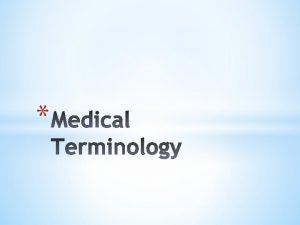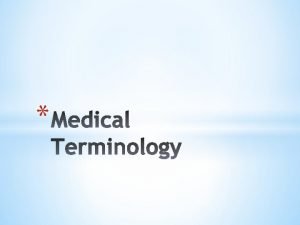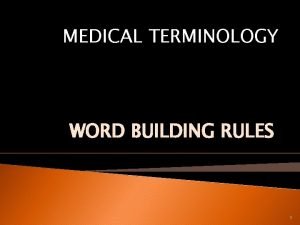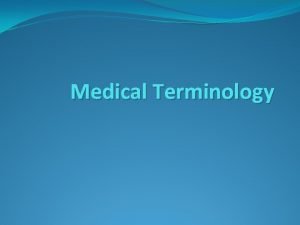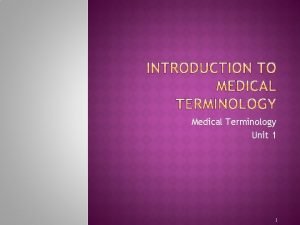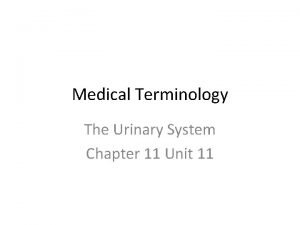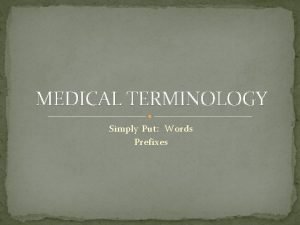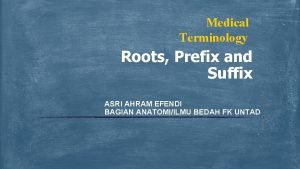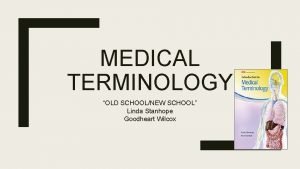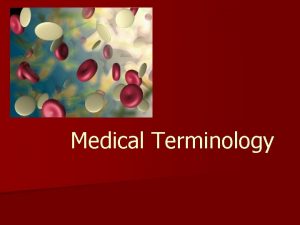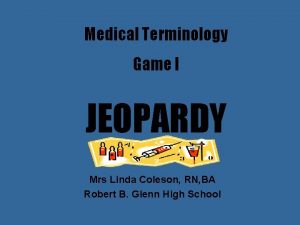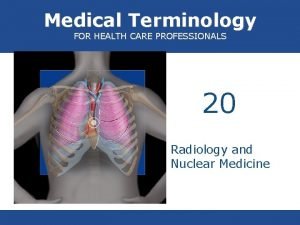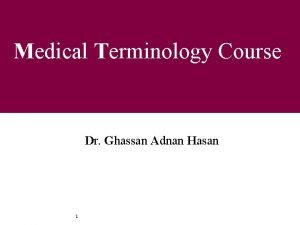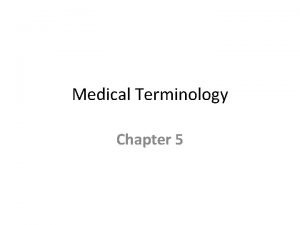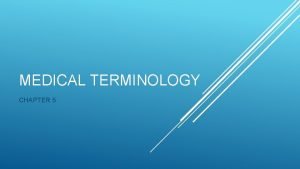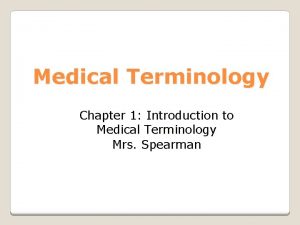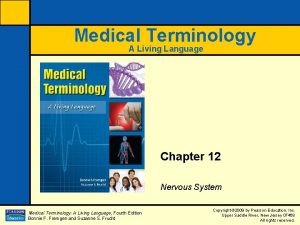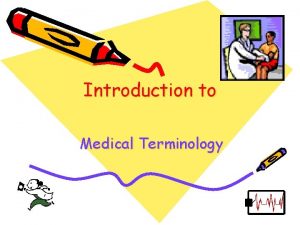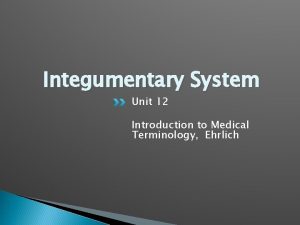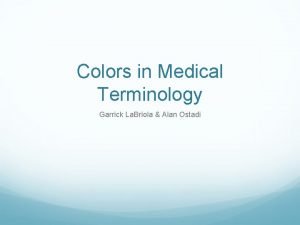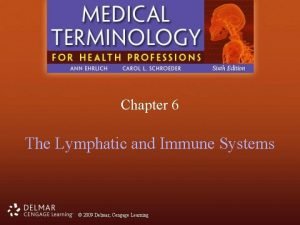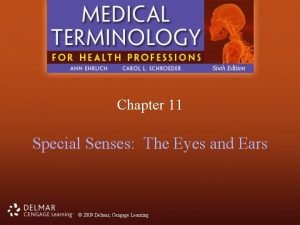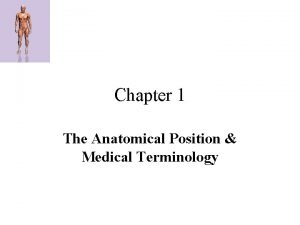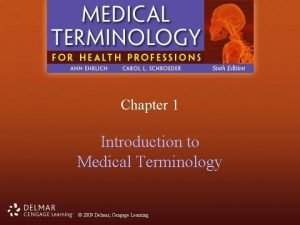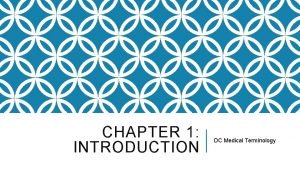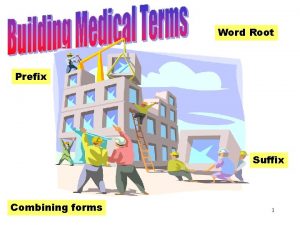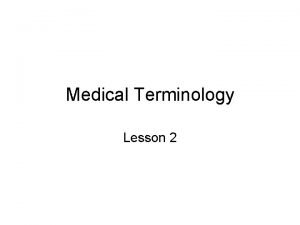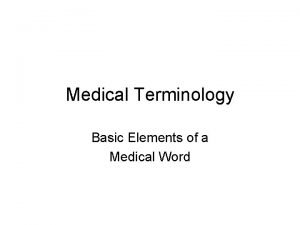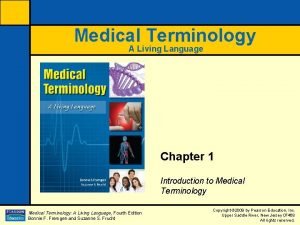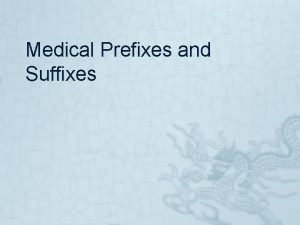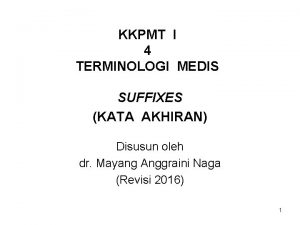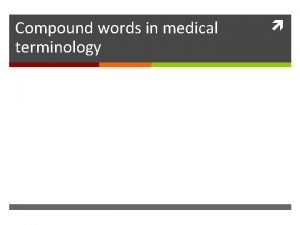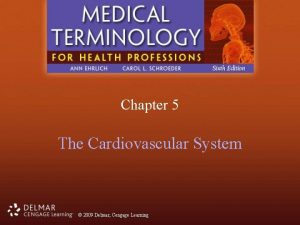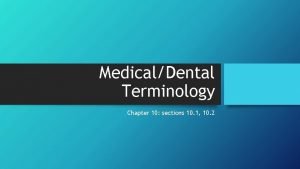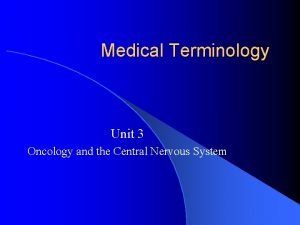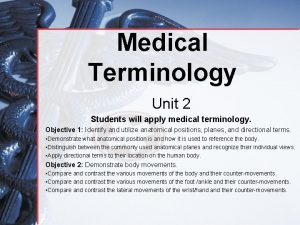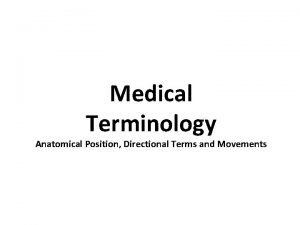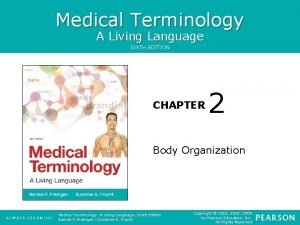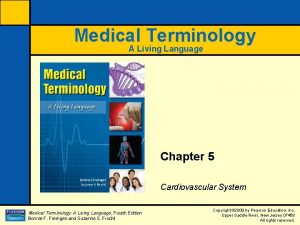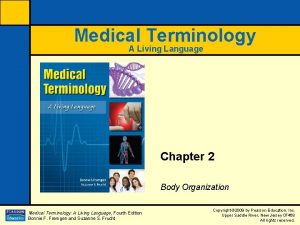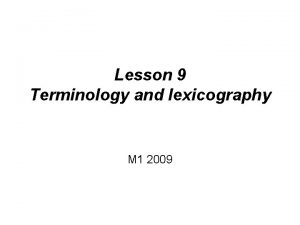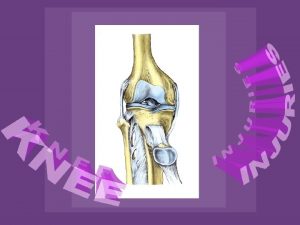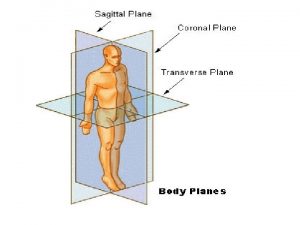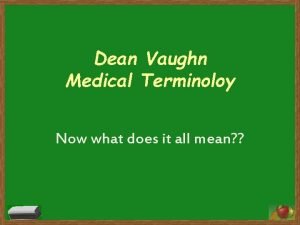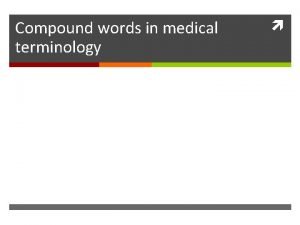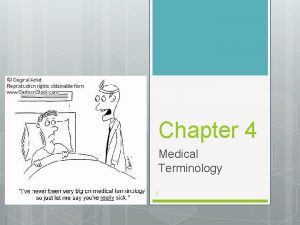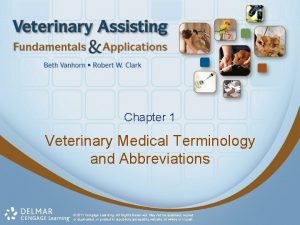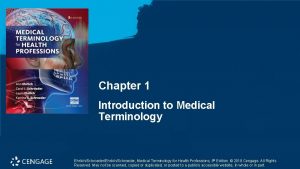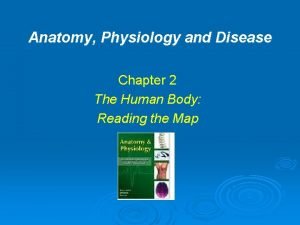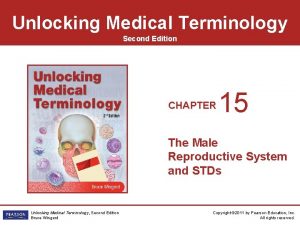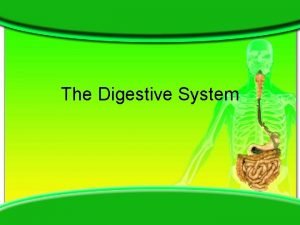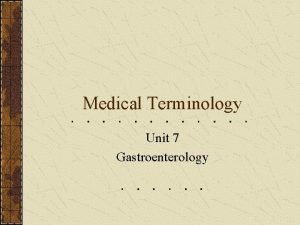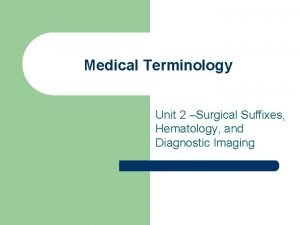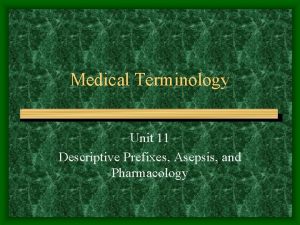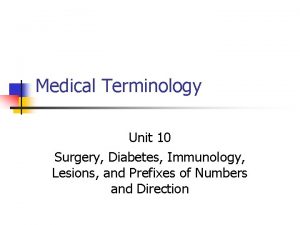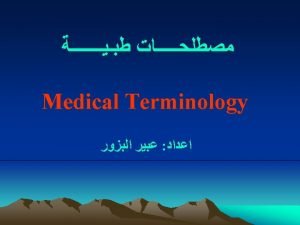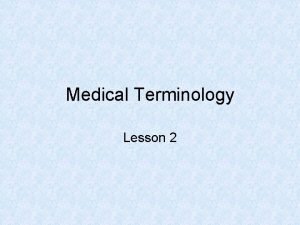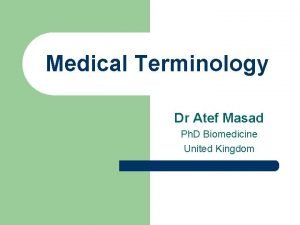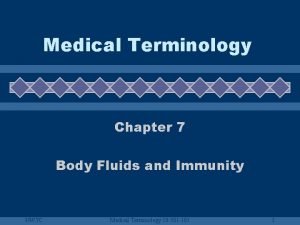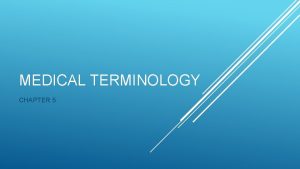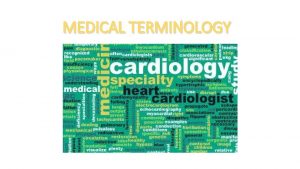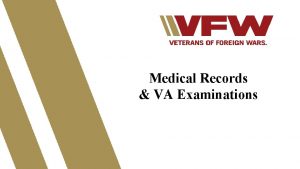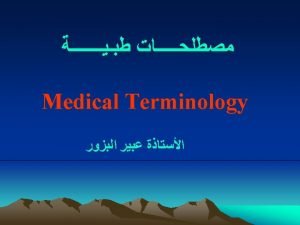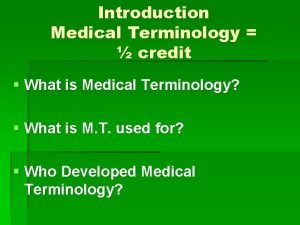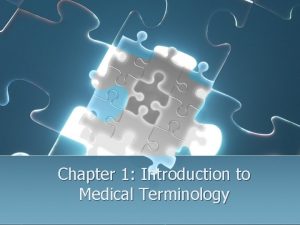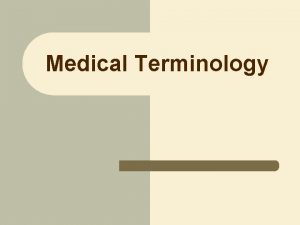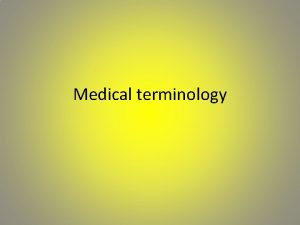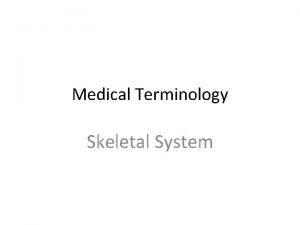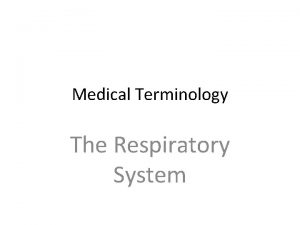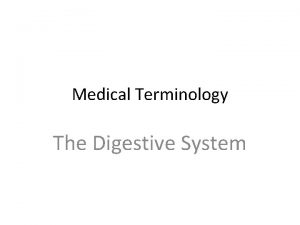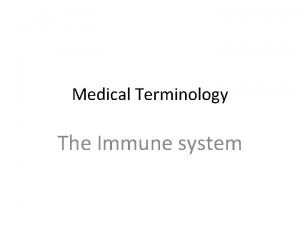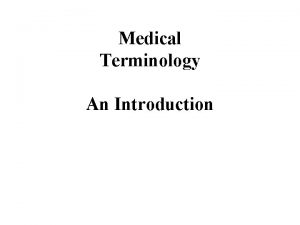MEDICAL TERMINOLOGY 1 Using medical terminology Medical terminology
















































































- Slides: 80

MEDICAL TERMINOLOGY 1

Using medical terminology �Medical terminology is used in: ◦ conversation with other professionals ◦ medical charting and documentation ◦ professional texts, journal articles 2

Using medical terminology �Understanding and using medical terminology correctly is essential to a successful midwifery career �Why is this essential? 80 slides total 3

Medical terminology • Each health care specialty has its own terminology and abbreviations • Health care professionals become so used to the language of their specialty they forget others don’t understand these terms 80 slides total 4

When not to use medical terminology �Medical conditions, diagnoses, treatments and terms should always be explained in lay person’s language when talking to patients, family and community members �Be aware of the client’s literacy level and language of origin 80 slides total 5

Building blocks of medical language �Medical terms are made up of several parts – elements - that can be combined to make many different words �Learning the meaning of these elements helps understand many medical terms 80 slides total 6

Building blocks of medical language 3 principle elements make up medical terms: 1. roots and combining forms 2. prefixes 3. suffixes 80 slides total 7

Each element is essential to understanding the meaning of the medical term Prefix Root Combining Vowel 80 slides total Suffix 8

The Root The root is the part of the medical term that gives the main meaning • It usually refers to a structure and/or function of the body • Roots are usually Latin or Greek in origin • All medical terms have at least one root • 80 slides total 9

Combining forms �Combining forms consist of roots plus a vowel, usually the letter “o” �In the dictionary, the vowel is separated from the root with a slash mark, example: �Gastr/o - stomach �Enter/o – small intestine �Cardi/o - heart 80 slides total 10

Combining vowel �The letter “o” is called the combining vowel �It links the root to the “suffix, ” the next element in the medical term �Used if the suffix begins with a consonant. �Not needed if the suffix begins with a vowel 80 slides total 11

Roots and combining forms �There are thousands of roots and combining forms that make up medical language �You need to learn the roots and combining forms used in general medical terminology and what is specific to maternity care 80 slides total 12

Basic root words Adip/o Arteri/o Arthr/o Axill Blephar Bucca Cardi/a Cephal Cerebr/o fat artery joint armpit eyelid cheek heart head brain 80 slides total 13

Basic root words Cervic Cholecyst Col/o Cost/o Crani/o Cyst/o Cyt/o Derm Enter neck gallbladder large intestine rib skull urinary bladder cell skin small intestine 80 slides total 14

Basic root words Esophag esophagus Gastr/o stomach Hem/o blood Hepat/o liver Ren/o, nephr/o kidneys Lapar abdominal wall Laryng/o larynx Lumbus loin, lower part of the back 80 slides total 15

Basic root words Myel/o spinal cord My/o, muculo muscle Nas/o, rhino nose Neur/o nerve Ophthalm/o, ocul/o eye Or/o, stomat/o mouth Oste/o bone Ot/o ear Pancreat/o pancreas Pharyng/o throat 80 slides total 16

Basic root words Pneum/o, pneumon/o Splen/o Thorac/o Thyroid Trache/o Ven/o, phleb/o Vertebr/o Viv/o lung spleen chest thyroid gland windpipe, trachea vein vertebra life 80 slides total 17

Combining forms �The letter “o” is called the combining vowel �It links the root to the “suffix, ” the next element in the medical term, if the suffix begins with a consonant. �The combining form is always used when linking two roots, even if the second one starts with a vowel. 80 slides total 18

Suffixes �Suffixes are word elements that are attached to the end of roots and combining forms to add to or change their meaning �All medical terms have a suffix 80 slides total 19

Suffixes �Each suffix can be added to many roots itis = inflammation appendicitis = inflamed appendix arthritis = inflamed joint 80 slides total 20

Suffixes �The combining vowel is used between the root and the suffix when the suffix begins with a consonant: Example: cardi + o + megaly = cardiomegaly = enlarged heart cardi = heart, megaly = enlarged 80 slides total 21

Suffixes �When the suffix begins with a vowel, there is no need for a combining vowel between the root and the suffix �The suffix is attached to the root word Example: gastr + itis = gastritis = inflammation of the stomach gastr = stomach, itis = inflammation 80 slides total 22

Suffixes Some common meanings of suffixes: • Pathological (disease) conditions • Diagnostic procedures • Surgical procedures • Pertaining to • Produced by • Resembling 80 slides total 23

Suffixes When suffixes are listed in medical dictionaries or word lists, they are listed alphabetically • The word is preceded by a dash and identified as a word element • The dash indicates something precedes it • Dictionary entries will give the language of origin, usually Latin or Greek • 80 slides total 24

Common suffixes Pertaining to: -ac, -al, -ary, -eal, -iac, -ical, -ose, ous, -tic Examples: Cardiac (pertaining to the heart) Cellular (pertaining to the cell) Psychotic (pertaining to psychosis) Corporeal (pertaining to the body) 80 slides total 25

Common suffixes -algia pain -centesis surgical puncture to remove fluid -cide to kill, destroy -cyte cell -ectomy removal of -emia blood -gram record 80 slides total 26

Common suffixes -graphy -ia, - a instrument used to record process of recording condition, esp. an abnormal state -ism condition -itis inflammation of -lithiasis presence of or formation of stones 80 slides total 27

Common suffixes -logy -logist -megaly -oid -oma -otomy -pathy -plasty study of person who studies it enlargement resembling tumor surgical incision disease surgical repair 80 slides total 28

Common suffixes -plegia paralysis -pnea breathing, respiration -rrhea drainage, flow -scope examination, instrument -scopy examination using a scope -stasis stoppage -stomy surgically create an artificial mouth or stoma 80 slides total 29

Prefixes �Prefixes are word elements that are attached to the beginning of roots and combining forms to add to or change their meaning �Many (but not all) medical terms have a prefix 80 slides total 30

Prefixes Common meanings of prefixes: Location Position Direction Time Number Negation, absence of Color 80 slides total 31

Prefixes �The same prefixes can be attached to many root words, resulting in thousands of variations �The prefix “hyper” means “abnormally increased or excessive” Hyperacid = excessively acidic Hyperactive = abnormally active Hypertension = persistently high blood pressure 80 slides total 32

Prefixes �Prefixes can dramatically change the meaning of a word �Example: “systole” means “contraction of the heart” �The one letter prefix “a” means “without” �“Asystole” means “no contractions of the heart” -- Just one letter makes the difference between life and death! �Correct spelling is critical in health care 80 slides total 33

Prefixes �When prefixes are listed in medical dictionaries and word lists, they are located alphabetically followed by a dash and identified as a word element �Their origin (Latin, Greek) is usually given �Example: epi- word element (Gr) meaning over poly- word element (Gr) meaning many, much 80 slides total 34

Common prefixes A-/an. Anti. Auto. Bi. Brady. Dys. Epi- without, not against self two, double slow bad, difficult, painful over 80 slides total 35

Common prefixes Eu. Hemi. Hyper. Hypo. Inter. Intra. Multi. Non. Peri- good, normal half above, excessive less than, under between within many not around 80 slides total 36

Common prefixes Poly. Post. Pre. Pseudo. Quadri. Semi. Sub. Supra. Tachy. Tri- many, much after, behind before, in front false four half under, below above, over fast, rapid three 80 slides total 37

Putting it all together �Learn the meanings of commonly used word elements and understanding how they combine to make a medical term �Then you can figure out the meaning of thousands of medical terms �Think of each word as a combination of building blocks or railroad cars, fitted together to create a precise meaning 80 slides total 38

Putting it all together The medical term is put together like a series of building blocks or train cars Prefix + Root + Combining vowel (if needed) + Suffix 80 slides total 39

Putting it all together – linking the components to define the term Prefix Root Combining Vowel 80 slides total Suffix 40

Putting it all together �When you see a new term, break it down into the elements �Start at the end of the word and work to the left �Identify and define each element �As you define each element you will define the medical term 80 slides total 41

Start at the end of the word and work to the left Prefix Root Combining Vowel 80 slides total Suffix 42

Example: “Echocardiogram” echo cardi o gram 80 slides total 43

Define Echocardiogram reading from left to right Echo = reflections of sounds Cardi = heart O= connecting vowel 80 slides total Gram = Written, record 44

Define Echocardiogram reading from left to right Echo = reflections of sounds Cardi = heart O= connecting vowel Gram = Written, record Echocardiogram is defined as a written recording of the heart using reflections of sounds 80 slides total 45

Putting it all together Prefix + root + (connecting vowel) + suffix Echocardiogram �echo = reflections of sounds �cardi = heart �o = connecting vowel �gram = written, record Echocardiogram is a written recording of the heart using reflections of sounds 80 slides total 46

Example: “Cytology” No Prefix Cyt o logy 80 slides total 47

Putting it all together Prefix + root + (connecting vowel) + suffix Cytology �Cyt (root) = cell �o = the connecting vowel �logy = (suffix) study of Cytology means study of the cell A cytologist is someone who studies cells 80 slides total 48

Example: “Bradycardia” Brady cardi No Connecting vowel 80 slides total ia 49

Putting it all together Prefix + root + (connecting vowel) + suffix Bradycardia • Brady = abnormally slow • no connecting vowel is needed because the prefix ends with a vowel • cardi = heart • ia, a = condition, esp. an abnormal state Bradycardia means a condition of abnormally slow heart 80 slides total 50

Example: “Splenectomy” No prefix splen No Connecting vowel 80 slides total ectomy 51

Putting it all together Prefix + root + (connecting vowel) + suffix Splenectomy �splen = (root) spleen �no connecting vowel is needed because the suffix begins with a vowel �ectomy = (suffix) removal of Splenectomy means removal of a spleen 80 slides total 52

Putting it all together Prefix + root + (connecting vowel) + suffix Dyspnea �Dys = bad, difficult, painful �pnea = breathing, respiration �ia, a = condition, esp. an abnormal state Dyspnea means an abnormal condition of difficult breathing 80 slides total 53

Putting it all together Prefix + root + (connecting vowel) + suffix Hemocyte �hem = blood �o = connecting vowel �cyte = cell Hemocyte is a blood cell 80 slides total 54

Changing the meaning of the term Changing one element modifies the meaning of the term 80 slides total 55

brady Bradycardia: a condition of abnormally slow heart Tachycardia: a condition of abnormally fast heart cardi tachy No Connecting vowel 80 slides total a 56

Tachycardia: a condition of abnormally fast heart Tachypnea: a condition of abnormally fast breathing cardi tachy pne No Connecting vowel 80 slides total a 57

Spelling �Correct spelling is critical in health care. �Misspelled words can lead to diagnostic, medication and treatment errors �Some words look or sound similar and can be confused 80 slides total 58

Spelling �Pay attention to the context to help you figure out the correct meaning of a term �Example: “The client has a fractured ilium” ilium = part of the hip bone ileum = part of the intestine 80 slides total 59

Singular and plural �Because many medical terms come from Greek and Latin words, the plural forms of the words are not made by adding an “s” as in English �Memorize the guidelines �When in doubt, memorize the specific words 80 slides total 60

Changing singular to plural If the word Change it Examples: ends in to singular, plural -a -ae vertebra, vertebrae -ex or -ix -ices index, indices -itis -nx -on -um -us -es -ides -ges -a -a -i diagnosis, diagnoses arthritis, arthritides phalanx, phalanges ganglion, ganglia ovum, ova alveolus, alveoli 80 slides total 61

Pronunciation guidelines The “soft” pronunciation of the consonant is used when followed by e, i or y • “c” sounds like “s” cell, circulation, cyst • “g” sounds like “j” when followed by e, i or y genetic, gingivitis, gestation • “ch” sounds like “k” chronic, chromium, cholecystitis, psychologist • 80 slides total 62

Pronunciation guidelines �When a word ends in “i” it is pronounced like “eye” as in bacilli �“x” is pronounced “z” as in xylocaine xenophobic 80 slides total 63

Pronunciation guidelines When “P” is at the beginning of words followed by a consonant: �“ph” is pronounced “f” as in pharmacy �“pn” is pronounced “n” (silent “p”) as in pneumonia, pneumococcus �“ps” is pronounced “s” (silent “p”) as in psychotic, psychosocial psychologist 80 slides total 64

Abbreviations & symbols �Medical abbreviations and symbols are a “short hand” for medical professionals �Most have been standardized and are universally accepted 80 slides total 65

Abbreviations & symbols • Individual facilities and specialties may use their own specific abbreviations and symbols or use a symbol differently Example: Means “change” • In maternity care it is also used to mean “trimester” 80 slides total 66

The context indicates the meaning �Client S. J. , 24 yo, 8 weeks gestation, c/o 1 st bleeding �Client S. J. , 24 yo, 8 weeks gestation, c/o constipation. Recommend her PNV Rx @ her next PNV. 80 slides total 67

Abbreviations & symbols �Don’t assume you know what an abbreviation or symbol means. �Learn the abbreviations and symbols used on your clinical site during orientation to the practice, through chart review, and by asking. 80 slides total 68

Abbreviations & symbols �Don’t use your own personal abbreviations in health care documents. �Use only standard medically accepted abbreviations and those used by the facility on your clinical site �Use capital and small letters appropriately �Non-standard abbreviations can result in medical errors and fines for the agency when discovered during chart audits 80 slides total 69

Common abbreviations & symbols ā before ad lib freely; at will a. c. before a meal b. i. d. twice a day BM bowel movement BP blood pressure c with CDC Centers for Disease Control 80 slides total 70

Medical abbreviations & symbols c/o complains of d/c discontinue h. hour H 2 O water h. s. At night, at bedtime I&O intake and output lab. Laboratory n. p. o. Nothing by mouth n&v nausea and vomiting 80 slides total 71

Medical abbreviations & symbols O 2 O. D. O. S. O. U. p P p. c. P. O. oxygen Right eye Left eye Each eye after pulse After meals By mouth 80 slides total 72

Medical abbreviations & symbols p. r. n. As needed q. d. Daily, once a day q. h. Every hour q. i. d. Four times a day R respiration RR respiration rate s without stat. immediately 80 slides total 73

Medical abbreviations & symbols T t. i. d. TPR Tx VS Wt. x temperature Three times a day temperature, pulse and respiration Treatment; traction vital signs Weight multiplied by 80 slides total 74

Medical symbols > < ↓ ↑ ↘ ↗ # greater than less than decreased, down, lower increased, higher, up, elevate decreasing increasing pound or number 80 slides total 75

Medical symbols ′ ″ o ♂ ♀ ∆ @ foot or minute inch or second degree male female change, trimester at 80 slides total 76

Medical Dictionary �Taber’s or Mosby’s available in bookstores, come with textbooks and CDs �Medical dictionaries are available online �Add medical terms to your computer’s spell check program 80 slides total 77

Choosing a medical dictionary �Explanations of medical procedures, conditions, disorders and diseases �Clear, easy to understand definitions �Pronunciation guidelines �Abbreviations and symbols �Useful diagrams, charts, reference tables containing information like lab values, conversion tables (metric to standard), etc �Vocabulary useful to your chosen field 80 slides total 78

Learn medical terminology • • • Study and learn a few words every day Make flash cards Practice using terms verbally Use symbols and abbreviations when you write notes Use a medical dictionary for reference Ask for a definition when you hear a term or see an abbreviation that you don’t know 80 slides total 79

1120 LEGAL AND ETHICAL ASPECTS OF MIDWIFERY MEDICAL TERMINOLOGY THE END 80 slides total 80
 Using system.collections.generic
Using system.collections.generic Accumulator ac
Accumulator ac Chapter 11 medical terminology
Chapter 11 medical terminology Medical terminology skeletal system
Medical terminology skeletal system The body is erect
The body is erect Lesson 6 medical terminology
Lesson 6 medical terminology Lesson 12 medical terminology
Lesson 12 medical terminology Coel prefix
Coel prefix Erythrocytopenia suffix
Erythrocytopenia suffix Gastric prefix and suffix
Gastric prefix and suffix Khan cademy
Khan cademy Megalocardia word root
Megalocardia word root Did terms
Did terms Ophthalmic medical terminology
Ophthalmic medical terminology Esis medical term examples
Esis medical term examples Hyperproteinuria definition
Hyperproteinuria definition Hepa medical term prefix
Hepa medical term prefix Prefix root word and suffix in medical terminology
Prefix root word and suffix in medical terminology Stanhope chapter 13 quizlet
Stanhope chapter 13 quizlet Basic medical terminology list
Basic medical terminology list Crit medical terminology
Crit medical terminology Medical terminology
Medical terminology Colors medical terminology
Colors medical terminology Jeopardy terminology
Jeopardy terminology Medical terminology for x ray
Medical terminology for x ray Retrogastric accented syllable
Retrogastric accented syllable Chapter 5 medical terminology quiz
Chapter 5 medical terminology quiz What is a consonant in medical terminology
What is a consonant in medical terminology Introduction to medical terminology chapter 1
Introduction to medical terminology chapter 1 Medical term for standing
Medical term for standing Radicul/o medical term
Radicul/o medical term Dorsal recumbent position
Dorsal recumbent position Medical terminology symbols
Medical terminology symbols Exfoliative dermatitis
Exfoliative dermatitis Albus medical term
Albus medical term Chapter 6 learning exercises medical terminology
Chapter 6 learning exercises medical terminology Chapter 11 labeling exercises
Chapter 11 labeling exercises Anatomical position medical terminology
Anatomical position medical terminology Medical terminology chapter 1 learning exercises answers
Medical terminology chapter 1 learning exercises answers Clast medical term
Clast medical term Cytosis suffix medical term
Cytosis suffix medical term Medical terminology lesson 4
Medical terminology lesson 4 Medical terminology lesson 8
Medical terminology lesson 8 Pne/o medical term
Pne/o medical term Algia medical terminology
Algia medical terminology Medical word elements
Medical word elements Sialaden/o
Sialaden/o A living language medical terminology
A living language medical terminology Hyperglycemia prefix and suffix
Hyperglycemia prefix and suffix Rrhaphy adalah
Rrhaphy adalah Compound word in medical terminology
Compound word in medical terminology Chapter 5 learning exercises medical terminology
Chapter 5 learning exercises medical terminology Medical terminology lesson 7
Medical terminology lesson 7 Chapter 10 labeling medical terminology
Chapter 10 labeling medical terminology Fast medical term
Fast medical term Hematology oncology terminology
Hematology oncology terminology Medical terminology unit 2
Medical terminology unit 2 Terms of position and direction
Terms of position and direction Medical terminology
Medical terminology 5.1 image labeling medical terminology
5.1 image labeling medical terminology Torso medical term
Torso medical term Medical terminology lesson 9
Medical terminology lesson 9 Erect position medical terminology
Erect position medical terminology Directional term
Directional term Orchidopex
Orchidopex Compound in medical terms
Compound in medical terms Cardi meaning medical
Cardi meaning medical Gib medical abbreviation
Gib medical abbreviation Introduction to medical terminology chapter 1
Introduction to medical terminology chapter 1 Erect position medical terminology
Erect position medical terminology The combining form andr/o means
The combining form andr/o means Gastrointestinal medical terminology breakdown
Gastrointestinal medical terminology breakdown Medical terminology lesson 3
Medical terminology lesson 3 Proct medical term
Proct medical term Surgical suffixes examples
Surgical suffixes examples Supra medical terminology
Supra medical terminology Necr/o
Necr/o Cide medical term
Cide medical term Medical terms that sound alike
Medical terms that sound alike Clasis a suffix denoting break, fracture
Clasis a suffix denoting break, fracture Nucleloid
Nucleloid
